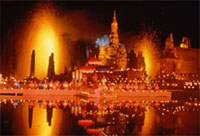| |
| Water Festivals (excerpt) |
 |
 Without water,
there would be no celebration of Thailand's two most important festivals.
Songkran requires copious amounts of it to bless images and friends;
the beautiful Loy Krathong can only take place in flowing or still
water. Without water,
there would be no celebration of Thailand's two most important festivals.
Songkran requires copious amounts of it to bless images and friends;
the beautiful Loy Krathong can only take place in flowing or still
water.
Phya Nak and its cohorts are essential participants in Songkran, an ancient Indian rite conducted to ensure a healthy rainfall. Songkran reached Thailand via Burma in the 11th century, during the reign of King Anawrahta (r. 1044-77) of Bagan. Still observed in Burma, it has derivatives in Laos, Cambodia, and southern China. In Thailand, Songkran formerly marked the beginning of the lunar new year and was celebrated on the first day of the waxing moon in the fifth month (April). After the 1932 revolution, the date was fixed at April 13th.
The term "Songkran" describes the sun's passage from one astrological house to another, and is seen as a means to explain and avert drought. The legend that explains the celebration involves seven heavenly sisters, concubines of the god Phra In (Indra). They were the daughters of a deity named Kapila-brahma, who descended to earth to ask riddles of a seven--year-old prodigy, Dharmapala Kumar. If the lad failed to answer the riddles within seven days, his head would be cut off. If he succeeded, the god would sever his own head…
…Up to seven nak take part in Songkran. Their exact number determines the amount of rainfall which will fall during the coming year. Contrary to expectation, the number is in inverse relationship to the amount of rainfall; that is, the more nak, the less rain. It is believed that a large number of nak would waste time playing whereas one or two nak would concentrate on getting the job done. Another interpretation suggests that a large number of nak would, like Phya Nak, swallow up all the earth's water leaving none to shower the earth.
In Bangkok, on the day before Songkran, the kingdom's second most sacred Buddha image, the Phra Buddha Sihing, is removed from its normal resting place in Wat Buddhaisawn in the National Museum and placed on a special carriage. It is then carried in procession around the old royal city. Buddhists lining the route fling bowls of water to wash the residue of the old year from the image. It is then installed in Bangkok's Sanam Luang, the oblong field adjacent to Wat Phra Kaew, where worshipers continue their obeisance throughout the day…
…In the North, Songkran eve is spent with friends. At dawn, young men shoot guns and firecrackers to drive away evil spirits which have sullied the previous year. In the North and the Central Plains, residents clean their houses, kitchen utensils, and wash their clothes and bedsheets to purify themselves for the coming year. They then sprinkle water on each other to wash away bad luck and bestow blessings. Because the Songkran celebration requires enormous quantities of water, it is to rivers that celebrants go. As the day progresses, the volume of water and the force with which it is propelled increases until the event degenerates into boisterous water wars involving buckets and hoses. Youths drive around the larger towns in pick-up trucks freighted with barrels of water which they generously lavish on passersby. At the same time, worshipers release fish into rivers and ponds and free birds from their cages, meritorious deeds whose goodness will hopefully redound in the new year. In the courtyards of northern wat, devotees build small stupa of sand carried from the river and insert small flags in their summits. Their gift raises the level of the courtyard, replacing all the soil inadvertently carried out of the compound in shoes and cuffs during the previous years…
…Thailand's second most important festival, Loy Krathong, also has roots in antiquity. In the Lanna kingdom seven centuries ago, the Loy Khro (float away misfortune) ceremony was presided over by the king. He placed a personal object like a piece of clothing in a banana leaf tray and launched it into the Ping, symbolically floating away Chiang Mai's ill fortune and, by extension, cleansing the entire Lanna kingdom. That afternoon, the king would pour scented water on an important Buddha image associated with rain-calling, such as the Phra Buddha Sihing at Wat Phra Singh and the Phra Setang Khamani at Wat Chiang Mun.
Loy Krathong, Loi Khro's successor, is celebrated on the November full moon night when millions of tiny krathong (boats) are launched on the waterways. Slices of a banana tree trunk form the krathong hulls which are then beautifully decorated with flowers and leaves. As a final touch, a candle and incense sticks are installed like masts in the center. As the moon rises, each celebrant places a few small coins, fingernail clippings and a few of his or her own hairs in the krathong to symbolize the past year's ill luck. He lights the candles and incense while praying for success in the coming year, and then places the tiny boat in a river, canal, or lake. Thousands of similar krathong set afloat by other celebrants creates an enchanting spectacle of light shimmering on the water.
|
|



